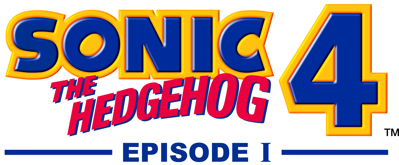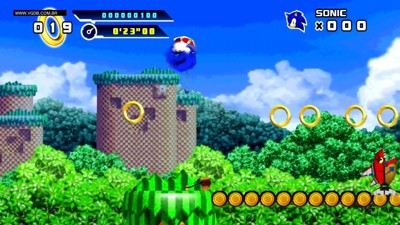Overview
Sonic the Hedgehog 4: Episode I is a side-scrolling platform game similar in gameplay and style to the 1990s Sonic the Hedgehog games for the Sega Genesis. The story begins shortly after the events of Sonic & Knuckles (1994). Sonic the Hedgehog parts with his friends, Miles "Tails" Prower and Knuckles the Echidna, to explore new territories on his own. However, series antagonist Doctor Eggman—who survived his defeat in Sonic & Knuckles—resurfaces, refines some of his past robots, and initiates a plan to get rid of Sonic. Sonic 4 is presented from a 2.5D perspective; although movement is restricted to a 2D plane, characters and objects are rendered in 3D. Sonic, the only player character of the single-player game, can move left or right to gain speed, jump, and roll into a ball to attack enemy robots. Sonic can also perform the "homing attack" from the 3D Sonic games; when in midair, he can lock on to robots or objects and home in on them. In some cases, chaining homing attacks opens access to alternate pathways.
The game takes place across four levels called zones, each split into three acts. Unlike the Genesis Sonic games, after completing the first act, the player can freely choose which zone to play via a world map. The levels are based on locations from the original Sonic the Hedgehog (1991) and Sonic the Hedgehog 2 (1992),[b] and feature elements such as slopes, bottomless pits, vertical loops, corkscrews, springs, and boost pads, as well as power-ups like shields, invincibility, and speed shoes. Some levels feature unique elements, like vines or pinball flippers and bumpers. After the player completes a zone's acts, they unlock a boss encounter with Eggman. Boss encounters feature Eggman piloting one of his robots, and the player must hit him eight times to defeat him. Completing all four zones unlocks a fifth and final level. Like other Sonic games, Sonic collects rings as a form of health: if the player is in possession of at least one ring and is hit by an enemy or hazard, they will survive, but their rings will scatter and blink before disappearing. If the player is hit with no rings, falls in a pit, or drowns, they lose a life, and will receive a game over if all lives are lost.
If the player finishes an act with 50 or more rings, they will have the option to access a special stage. The special stages in Episode I are based on those from Sonic the Hedgehog, in which Sonic is curled in a ball and bounces off the bumpers and walls of a fully rotating maze. The player must tilt the playing field to navigate Sonic through the maze within a time limit, collecting rings to open gates and time bonuses along the way. Finishing the special stage rewards the player with one of the seven Chaos Emeralds. By collecting all seven, the player unlocks the ability to transform into Super Sonic, granting them invincibility and increased speed at the cost of one ring a second. Collecting the Chaos Emeralds also unlocks a brief post-credits scene that shows a silhouette of Metal Sonic, teasing the events of Sonic the Hedgehog 4: Episode II (2012). Players are also able to upload their game information to online leaderboards to compare level completion times and high scores.
Each version of the game is mostly identical, save for differences in screen size and resolution. For instance, the PlayStation 3, Xbox 360, and Windows versions support high-definition and widescreen displays, whereas the Wii version does not. Additionally, the PlayStation 3 and Wii versions both support their systems' respective motion controllers. The mobile versions can be controlled with either the accelerometers or virtual buttons on the touchscreen. Two levels exclusive to these versions are designed around the use of the accelerometers.
- Developers
- DimpsSonic TeamPlaysoft Games
- Publishers
- Sega
- Platform
- Ouya
- Genre
- Platform
- Alternate Names
- Sonic 4 Episode 1
- Sonic 4






